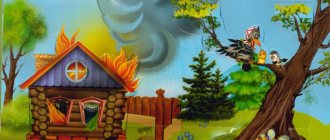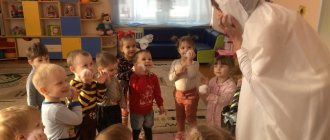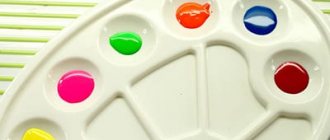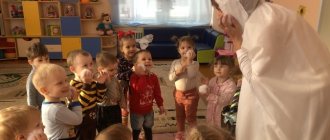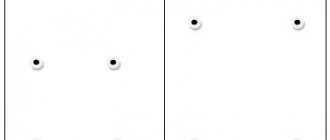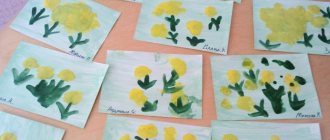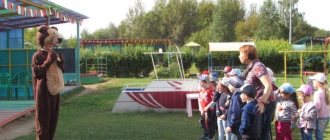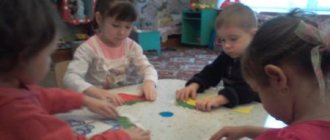How to recognize disorders and when to contact a speech therapist?
The list presented above is general in nature, but if at least three points from it are not characteristic of a child’s speech behavior, this is a reason to think about it.
Here are some signs that may indicate a delay in your child's speech development:
- the pace of his speech is uneven - he sometimes speaks too quickly, sometimes he drawls out his words;
- speaks unintelligibly, only his mother understands him;
- if he speaks in phrases, then not his own, but only those he heard from adults or on TV;
- he himself has difficulty understanding what adults tell him;
- mouth constantly open, like a limp mouth;
- increased salivation not associated with teething.
If one or more signs from this list are present, it is advisable to diagnose the child’s speech development. Perhaps there really is a pathological disorder that requires special treatment, or perhaps the baby just needs speech therapy exercises. But before contacting a speech therapist, you need to show the child to a neurologist, psychiatrist and speech pathologist: they will help determine whether the delay in speech development is associated with disorders of the central nervous system or the problem is only in the pronunciation of sounds. You may also need the help of an audiologist - a specialist who identifies hearing defects. If doctors have not found any physiological reasons for the development of mental retardation, then the child will benefit from sessions with a speech therapist.
9.A lot or a little?
Goal: to teach children to correlate the words “one”, “many”, “few” with the corresponding number of objects. Materials: in this game you can use small toys - cubes, sticks, balls, etc. Progress of the game: When forming the concepts of “one”, “many”, “few”, it is useful to teach children to use the appropriate gestures: “one” - show the index finger; “a lot” - a wide, circling hand gesture; “little” - a narrow, outward gesture with the hand, or fold your palms into a handful. To do this, the speech therapist constantly uses these gestures and encourages children to use them. The names of concepts should be highlighted in speech. The game is played on the carpet. Lay out the cubes in front of the children: one pile has a lot of cubes, and the other has few. Look, here are the cubes, and here are the cubes too. There are a lot of cubes here (the speech therapist shows the corresponding gesture), but there are few cubes here (the speech therapist shows the corresponding gesture). Show where there are few cubes. How do you show that there are not enough cubes? (the speech therapist encourages the children to show a gesture) Where are there a lot of blocks? How do you show that there are a lot of cubes? (the speech therapist encourages the children to show a gesture) And here is one cube. (the speech therapist shows the appropriate gesture) Take one cube at a time. Show that there is only one cube. (the speech therapist encourages the children to show a gesture) It is useful to repeat this game using different subject material.
11.Big or small?
Goal: to teach children to correlate the words “big” and “small” with the size of objects. Materials: in this game you can compare any toys and objects; You can use pictures in further work. Progress of the game: When forming the concepts of “big” and “small”, it is useful to teach children to use expressive gestures: “big” - spread your arms to the sides (or simultaneously up and to the sides), “small” - bring your palms closer to each other (or bring your hands closer to each other). index and thumb towards each other). To do this, the speech therapist constantly uses these gestures and encourages children to use them. The names of concepts should be highlighted in speech. Show the children the big and small balls. Look, here's a ball, and here's a ball too. Are the balls the same? No, the balls are different. This ball is big! (the speech therapist shows the appropriate gesture), and this ball is small (the speech therapist shows the appropriate gesture). What kind of ball is this - show me. (the speech therapist encourages the children to show the gesture) That’s right, small. What is this ball? Show! (the speech therapist encourages the children to show a gesture) It is useful to repeat this game using a variety of subject material.
The first session of a speech therapist with a child: where to start
Speech therapy classes are carried out for the following purposes:
- Understanding native speech, observing and comprehending everything that happens around. This is how the child learns about the world around him. The speech therapist forms general concepts, gives the basics of word formation, and teaches how to use complex phrases.
- Formation of correct pronunciation of words and development of phonemic hearing. Monitoring the clarity and expressiveness of speech.
- Teaching independent speech using different sentences.
Many people are interested in how the first speech therapist session is conducted. The first session of a speech therapist with a child, where to start:
- The child's disposition towards himself.
- Carrying out diagnostics and identifying problems.
- Introduction to the speech apparatus.
- Teaching simple speech therapy exercises and games.
- Building a work plan.
Literature to help the speech therapist: Fadeeva Yu. A., Pichugina G. A., “Speech therapy classes in the younger group”
The abstract by Fadeeva and Pichugina is intended for speech therapy classes in the younger group. It promotes the formation of speech skills in children two to three years old who have various speech problems of different etiologies. It is intended for speech therapists, speech pathologists, educators and parents.
Stages of working on a new word in speech therapy
Stages of working on a new word in speech therapy:
- Determining the relationship between a sound word and a visual, auditory and other image.
- Analysis of word composition.
- Identification of semantic features of a word.
- Introduction of a word into the semantic field.
- Consolidating the meaning of a word.
How specialists work: exercises, games, manuals
One of the most obvious reasons for the incorrect pronunciation of sounds by young children is the imperfection of their speech apparatus. Speech therapy gymnastics helps solve this problem.
There are many fun exercises that children enjoy doing in front of the mirror, repeating after the speech therapist.
- “Window” is the simplest exercise in which the baby must first open his mouth as wide as possible (“it’s hot, open the window!”), and then close it (“it’s cold!”).
- “Brushing your teeth” - the child needs to smile and in this state open his mouth slightly, then run his tongue over the upper and lower teeth, as if with a toothbrush.
- “Cup” - open your mouth again in a smile, stick your tongue out further and give it the shape of a bowl, raising the tip and edges.
- “Fipe” - diligently stretch out your lips, as if with the intention of whistling, while clenching your teeth.
- “Painting the ceiling” - smile, open your mouth slightly and move the tip of your tongue across the sky, as if painting it with a brush.
Children like this kind of gymnastics for the tongue, but it quickly tires them. At the next stage of the lesson, you can move directly to oral speech. Various descriptive games will help with this. For example, the teacher takes out an object or toy from a bag or box and asks the child to name it. Then he asks about the properties and characteristics of the object, pushing the child to describe it (the ball is round, green, small, bouncy). If successful, you can complicate the game: ask the child to put his hand into a bag with a toy and try to tell what it feels like.
The teaching aids include pipes and turntables for breathing exercises, finger toys and exercise machines, sets with tweezers for grasping small parts, tactile bags and boards - there is a very wide choice for professional speech therapists. You can purchase such things for home use, or you can make do with improvised means.
Groups of words suggested for memorization.
1. Subject dictionary.
Toys: ball, cube, car, doll, bear, bunny, ball, spinning top, bucket, shovel, pencils, book, etc. Parts of the body, face: legs, arms, belly, back, finger, head, neck, hair, eyes , ears, mouth, lips, teeth, nose, cheeks, eyebrows, forehead. Clothing and footwear: hat, scarf, mittens, jacket, coat, dress, skirt, blouse, shirt, trousers, tights, briefs, T-shirt, socks, slippers, boots, shoes, sandals, etc. Toilet items: soap, toothbrush, toothpaste, sponge, towel, comb, handkerchief, etc. House, apartment: house, door, lock, key, stairs, elevator, window, kitchen, room, bathroom, lamp, floor, ceiling, wall, etc. Furniture: table, chair, sofa, bed, wardrobe, shelf, hanger, etc. Household items: TV, telephone, clock, stove, refrigerator, fork, spoon, plate, cup, blanket, pillow, mirror, etc. Food and dishes : bread, bun, cheese, sausage, sausages, milk, butter, sour cream, cottage cheese, yogurt, cookies, juice, egg; porridge, soup, salad, sandwich, tea, compote, etc. Vegetables and fruits: cabbage, potatoes, carrots, onions, cucumbers, tomatoes; orange, banana, apple, pear, plum, etc. Plants: tree, bush, grass, flowers, berries, etc. Names of animals and birds that the child often sees: dog, cat, bird, dove, sparrow, crow, horse, etc. etc. Individual names of objects in the surrounding life: street, road, traffic light, cars, plane, swing, slide, park, etc. Individual names of phenomena in the surrounding life: water, earth, sun, sky, rain, snow, night, day, etc.
2. Verb dictionary.
The child’s own actions: walks, sits, stands, runs, jumps, sleeps, eats, plays, draws, builds, walks, rolls, washes, bathes, dresses, undresses, combs his hair, carries, falls, screams, speaks, sweeps, wipes and etc. Names of actions that people close to the child perform: reads, writes, draws, cleans, washes, irons, cooks, fries, sweeps, etc. Other actions: the phone rings; the car drives and hums; The plane is flying; leaves are falling, etc.
3. Adjectives, adverbs.
Names of some sensations and states: sweet, salty, sour, wet; cold, warm, hot, painful, tasty.
The name of some concepts: big, small; a lot, a little.
Work to expand the passive vocabulary of non-speaking children 2-3 years old is carried out both by a speech therapist and by the child’s relatives. Therefore, a speech therapist not only works with the child, but also works with parents.
What should the speech of a 3-4 year old child be like?
Scientists have calculated that at this age a child’s vocabulary ranges on average from 1,500 to 2,000 words. Such calculations are difficult to make at home, but there are several simpler indicators that can easily be used to determine how well a child’s speech development falls within the normal range.
There is no cause for concern if the child:
- actively tries to reproduce all the sounds and words he hears, especially those that are new to him;
- engages in word creation;
- makes simple sentences naming actions (the ball flies, the fish swims, the dog barks);
- tries to compose complex sentences and stories, but at the same time does not speak very clearly and makes many speech errors;
- can talk about himself in the third person;
- enjoys repeating many words after adults, quoting phrases from cartoons;
- does not pronounce all sounds; problems especially often arise with [r], [l], [s] and [w];
- rearranges letters and syllables in words;
- At the same time, he himself understands complex sentences, listens carefully to fairy tales, knows his favorites by heart;
- knows and knows how to say his first and last name, the names of relatives, friends, and the city in which he lives.
The listed signs apply to both boys and girls, although experts say that girls are ahead of boys in speech development by an average of 4-5 months. There are silent children who do not speak in front of strangers, but this does not always mean a deviation from the norm: a sensitive parent usually knows what his baby is really capable of.
At this time, it is important to talk to the child as much as possible, while making sure that your own speech is correct, not to lisp, and to read books to the baby with expression.
